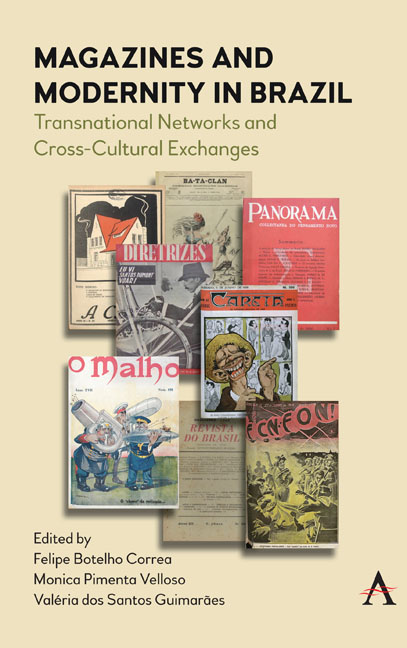Book contents
- Frontmatter
- Contents
- List of Figures
- List of Contributors
- Introduction
- Chapter 1 The French Periodical Print Culture In Brazil: A Survey of Catalogues and Mediators (1800–1945)
- Chapter 2 The Transnational Model of Popular Illustrated Magazines: Three Case Studies from Brazil (1900–20)
- Chapter 3 The Transnational Networks of the Modernist Periodical Print Culture: The Magazine Lumière in the Aftermath of WWI
- Chapter 4 Versions of Modernity in the Household Magazine A Casa (1923– 45)
- Chapter 5 Panorama Magazine and the Far-Right in Brazil (1936–37)
- Chapter 6 Against Nazi-Fascism in Brazil: The Case of the Magazine Diretrizes (1938–44)
- Chapter 7 Literary Inquiries and Disputes on Global Modernism: the Debate in Brazil During WWII
- Chapter 8 Modernity and Modernisms in the Magazine Sombra (1940–60)
- Index
Chapter 4 - Versions of Modernity in the Household Magazine A Casa (1923– 45)
Published online by Cambridge University Press: 04 February 2022
- Frontmatter
- Contents
- List of Figures
- List of Contributors
- Introduction
- Chapter 1 The French Periodical Print Culture In Brazil: A Survey of Catalogues and Mediators (1800–1945)
- Chapter 2 The Transnational Model of Popular Illustrated Magazines: Three Case Studies from Brazil (1900–20)
- Chapter 3 The Transnational Networks of the Modernist Periodical Print Culture: The Magazine Lumière in the Aftermath of WWI
- Chapter 4 Versions of Modernity in the Household Magazine A Casa (1923– 45)
- Chapter 5 Panorama Magazine and the Far-Right in Brazil (1936–37)
- Chapter 6 Against Nazi-Fascism in Brazil: The Case of the Magazine Diretrizes (1938–44)
- Chapter 7 Literary Inquiries and Disputes on Global Modernism: the Debate in Brazil During WWII
- Chapter 8 Modernity and Modernisms in the Magazine Sombra (1940–60)
- Index
Summary
This chapter explores how the magazine A Casa (The Household), published between 1923 and 1945, engaged with the transnational model of home interest magazines (also known as shelter magazines) that emerged in the nineteenth century, mediating modernity in Brazil through the household theme. The various possible approaches to this theme include the study of the relations between: gender and material culture; sociocultural class and domesticity; decorative schemes and psychological states; ways of life and formats of houses; producers and consumers; individuals and groups; visualities and materiality, the dialogues that permeate the inside face and the outface, the private sphere and the public sphere, among others. Here, however, the focus is on how households have been represented in a magazine, and how this publication mediated modernity to a Brazilian readership.
I follow Peter Burke's idea that innovation can be defined as adaptation and that cultural encounters encourage creativity. My argument is that the ideas of modernity expressed in the magazine A Casa have negotiated with the various transnational tendencies that appeared in Western home interest magazines of that period, in an attempt to strike a balance that could appeal to a readership based on the major metropolis of Brazil. With a clear commercial agenda, the magazine has drawn on national traditions from the architects who graduated from the National School of Fine Arts as well as on avant-garde trends brought by foreign professionals. A Casa promoted a myriad of modern possibilities to its aspiring readers, bringing together men and women in an editorial project that foregrounded up-to-date articles, inventive architectonic projects, renovated interiors, fashionable furniture and trendy decorations, as well as promoting the housing business through many advertisements, following the transnational model of household magazines.
A Casa ceased publication in 1945 and today it is a rich archival source on the debates around the idea of modernity when discussed in the context of architecture, design, interior decoration and shelter magazines in Brazil between the 1920s and 1940s. Such magazines are important sources for the histories of private life. The household is a place where we spend a great part of our lives, the place of escape and decisions, of conviviality and solitude, of inwardness and representation, the space of the individual, the family and of visitors too.
- Type
- Chapter
- Information
- Magazines and Modernity in BrazilTransnational Networks and Cross-Cultural Exchanges, pp. 77 - 94Publisher: Anthem PressPrint publication year: 2020



